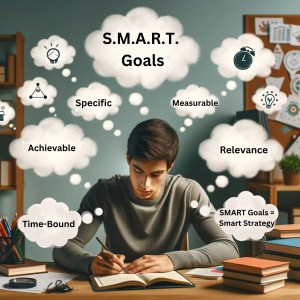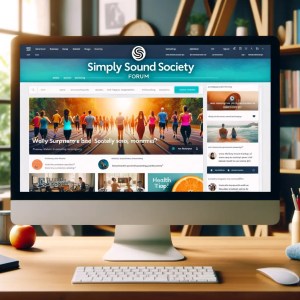- Introduction to Personal Growth Goals for Students
- SMART Personal Growth Goals for Students
- Broadening Horizons – Beyond Academic Goals
- Implementing SMART Goals for Holistic Student Development
- Maximizing Motivation: Keeping Students Engaged with Their Goals
- Conclusion: A Pathway to Personal and Academic Success
Are you a student eager to transform your academic journey and personal life? The secret to unlocking your full potential lies in setting SMART goals. Let’s embark on a transformative path that’s both ambitious and achievable!

Introduction to Personal Growth Goals for Students
In the dynamic world of student life, personal growth is a pivotal aspect of success, both academically and personally. But how can students transform their ambitions into concrete achievements? The cornerstone to this transformation is the SMART goals framework, a topic we delved into in our comprehensive guide, “Unlocking Success with S.M.A.R.T. Goals: Your Go-to Guide”.
Building on this, our article aims to provide students with practical examples and strategies to apply SMART goals specifically for personal growth. By enhancing academic prowess and nurturing essential life skills, we’ll navigate through a journey of impactful self-improvement.
Let’s explore how Personal Growth Goals for Students, shaped by SMART strategies, can pave the way for a brighter, more accomplished future.
SMART Personal Growth Goals for Students
Embarking on a journey towards personal growth requires more than just desire; it requires a plan. For students, setting Personal Growth Goals for students is a critical step in shaping their future.
These goals, when aligned with the SMART framework, become powerful tools for success. Let’s explore a variety of SMART goals that students can adopt to enhance their academic journey and personal development.
Academic Growth:
Meet Each Teacher: Establish a goal to meet with each teacher within the first two weeks of class. This clarifies expectations and fosters valuable relationships.
Advance in a Subject: Target specific improvements, such as elevating a grade in a challenging subject, through dedicated study plans and seeking extra help.
Skill Development:
Enhance Reading Skills: Set daily reading targets to improve fluency and comprehension, crucial skills for academic success.
Prepare for Extracurricular Success: Whether it’s theater, sports, or debate, set practice goals to excel in your chosen activities.
Personal and Social Growth:
Develop Peer Relationships: Aim to build new friendships or join new groups, expanding your social network and interpersonal skills.
Remember, the key to achieving these Personal Growth Goals for Students is in the specifics: clear, measurable, achievable, relevant, and time-bound objectives.
By focusing on these aspects, students can turn their aspirations into attainable goals, leading to significant personal and academic growth.
For a deeper dive into setting SMART goals, revisit our comprehensive guide, “Unlocking Success with S.M.A.R.T. Goals: Your Go-to Guide”.

Broadening Horizons – Beyond Academic Goals
While academic achievements are pivotal, the scope of personal growth for students extends far beyond the classroom. This section explores additional personal growth goals for students that encompass various aspects of life, fostering a well-rounded development.
Life Skills Enhancement:
Start a Growth Journal: Encourage self-reflection and emotional intelligence through journaling, an excellent tool for personal insight and growth.
Mindful Social Media Use: Set objectives to reduce social media consumption, thereby increasing real-life interactions and productivity.
Career Preparation and Financial Management:
Engage in Career Exploration: Pursue activities like internships or youth programs to gain early career insights and skills.
Financial Literacy: Establish goals like creating a budget or saving a specific amount by a certain age, essential skills for financial independence.
Community and Leadership:
Volunteer and Service Goals: Commit to community service, which enhances empathy, leadership, and social responsibility.
Leadership Roles: Seek out opportunities in school or community organizations to develop leadership and teamwork skills.
These broader Personal Growth Goals for Students help in developing a holistic skill set, essential for success in today’s multifaceted world. By setting SMART goals in these areas, students not only excel academically but also emerge as confident, capable, and socially responsible individuals.
Implementing SMART Goals for Holistic Student Development
(click on each bullet point to reveal each one)
SMART Goals Implementation
The implementation of SMART goals is a dynamic process that involves more than just goal setting. It’s about creating a sustainable plan that leads to real change and development in a student’s life. So, here are more personal growth goals for students.
- Self-Reflection:
- Breaking Down Goals:
- Writing Goals Down:
- Creating an Action Plan:
- Regular Review and Adjustment:
Start by understanding your strengths, weaknesses, and interests. This helps in setting goals that resonate with your personal aspirations and values.
Large goals can be overwhelming. Break them down into smaller, manageable tasks to maintain focus and motivation.
Documenting your goals enhances commitment. Use a journal, digital tools, or apps to keep track of your goals and progress.
Develop a step-by-step plan with specific tasks, resources, and deadlines. This makes your goals more actionable and achievable.
Goals are not set in stone. Regularly review your progress and be flexible to adjust your goals as needed.
By embracing these steps, students can effectively utilize the SMART framework to achieve their Personal Growth Goals. This approach not only enhances personal development but also empowers individuals to reach their full potential.

Maximizing Motivation: Keeping Students Engaged with Their Goals
(click on each bullet point to reveal each one)
Maintaining Motivation
Maintaining motivation is crucial for students to achieve their Personal Growth Goals. Here are strategies to keep the momentum going:
- Provide Success Opportunities:
- Foster a Sense of Control:
- Make Learning Fun:
- Clarify Learning Objectives:
- Track Progress:
- Create a Friendly Environment:
- Provide Constructive Feedback:
- Change the Scenery:
- Set Achievable Goals:
- Offer Hands-on Experiences:
- Manage Anxiety:
- Encourage Positive Competition:
- Reward Achievements:
- Know Your Students:
- Assign Responsibilities:
- Demonstrate Enthusiasm:
- Praise Efforts and Achievements:
- Promote Self-Reflection:
- Facilitate Group Work:
- Build Trusting Relationships:
- Offer Choices:
Recognize students’ achievements and efforts, giving them a sense of accomplishment and the motivation to continue striving towards their goals.
Empower students by allowing them to make choices in their learning process, which can include selecting their assignments or contributing to decision-making. This autonomy boosts their engagement and commitment to their goals.
Integrate enjoyable elements into the learning process, such as competitions or interactive activities, to keep students interested and motivated.
Ensure that students clearly understand their goals and the steps needed to achieve them. This clarity helps maintain their focus and direction.
Regularly monitor and acknowledge students’ progress towards their goals. This acknowledgment can be a powerful motivator and confidence builder.
Foster a supportive and welcoming atmosphere where students feel comfortable and motivated to participate and learn.
Regular feedback helps students understand their strengths and areas for improvement, guiding them toward their goals.
Occasionally altering the learning environment can refresh students’ minds and increase their motivation.
Encourage students to set realistic and attainable goals, creating a sense of possibility and success.
Practical experiences can be more engaging and memorable than theoretical learning, keeping students motivated to learn and apply new skills.
Help students manage stress and anxiety related to their goals, ensuring that these emotions don’t hinder their progress.
Healthy competition can be a great motivator, but it’s important to maintain a balance to ensure that it remains positive and encouraging.
Recognize and reward students for their efforts and accomplishments, which can significantly boost their motivation.
Understanding students’ personal interests and goals can help tailor motivational strategies to their individual needs.
Giving students responsibilities can help them develop a sense of ownership and commitment to their goals.
An enthusiastic approach can be contagious, inspiring students to engage more deeply with their goals.
Regularly praising students for their efforts and achievements fosters a positive self-image and encourages continued effort.
Encourage students to reflect on their learning and progress, helping them gain insight into their own development.
Collaborative activities encourage peer interaction and can motivate students through shared learning experiences.
Establishing a trusting relationship with students can make them feel supported and motivated in their academic pursuits.
Providing students with options in their learning process can enhance their engagement and commitment to their goals.
By incorporating these strategies, students can remain motivated and focused on their personal growth goals, ensuring a more productive and fulfilling academic journey.
Conclusion: A Pathway to Personal and Academic Success
In summary, the journey to personal growth for students is a multifaceted one, encompassing academic excellence, skill development, personal and social growth, life skills enhancement, career preparation, and financial management.
By adopting SMART goals, students can approach their growth with clarity, purpose, and effectiveness. Motivation plays a key role in sustaining these efforts, and by employing strategies like offering success opportunities, fostering a sense of control, and encouraging self-reflection, students can maintain their drive towards achieving their goals.
Remember, personal growth is not just about reaching a destination; it’s about the journey of self-discovery and continuous improvement.
We really hope that you enjoyed this article on personal growth goals for students! Please let us know in the comments.

Simply Sound Society: Join Our Supportive Community
As you embark on your journey of personal growth and goal setting, we invite you to join the Simply Sound Society. Our forum at Simply Sound Society is a vibrant community where like-minded individuals gather to share experiences, insights, and encouragement. Whether you’re seeking advice, looking to share your own success stories, or simply want to connect with others on a similar path, the Simply Sound Society is the perfect place for you. Join us today and be a part of a supportive community that uplifts and inspires each step of your personal growth journey.
Check out some of our other great reads:















